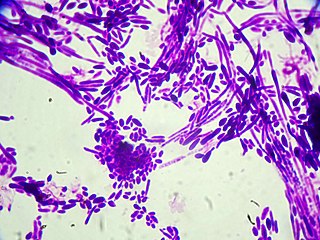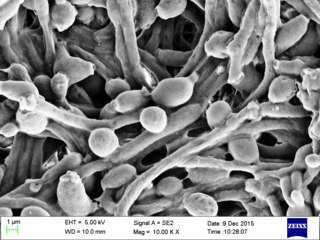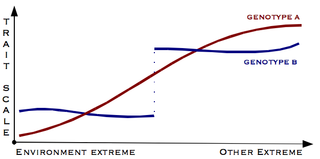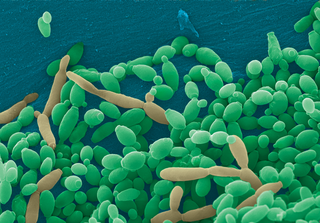Related Research Articles

In biology, epigenetics is the study of stable phenotypic changes that do not involve alterations in the DNA sequence. The Greek prefix epi- in epigenetics implies features that are "on top of" or "in addition to" the traditional genetic basis for inheritance. Epigenetics most often involves changes that affect the regulation of gene expression, but the term can also be used to describe any heritable phenotypic change. Such effects on cellular and physiological phenotypic traits may result from external or environmental factors, or be part of normal development.
A maternal effect is a situation where the phenotype of an organism is determined not only by the environment it experiences and its genotype, but also by the environment and genotype of its mother. In genetics, maternal effects occur when an organism shows the phenotype expected from the genotype of the mother, irrespective of its own genotype, often due to the mother supplying messenger RNA or proteins to the egg. Maternal effects can also be caused by the maternal environment independent of genotype, sometimes controlling the size, sex, or behaviour of the offspring. These adaptive maternal effects lead to phenotypes of offspring that increase their fitness. Further, it introduces the concept of phenotypic plasticity, an important evolutionary concept. It has been proposed that maternal effects are important for the evolution of adaptive responses to environmental heterogeneity.

Candida dubliniensis is a fungal opportunistic pathogen originally isolated from AIDS patients. It is also occasionally isolated from immunocompetent individuals. It is of the genus Candida, very closely related to Candida albicans but forming a distinct phylogenetic cluster in DNA fingerprinting. It is most commonly isolated from oral cavities, and is also occasionally found in other anatomical sites.

Candida albicans is an opportunistic pathogenic yeast that is a common member of the human gut flora. It can also survive outside the human body. It is detected in the gastrointestinal tract and mouth in 40–60% of healthy adults. It is usually a commensal organism, but it can become pathogenic in immunocompromised individuals under a variety of conditions. It is one of the few species of the genus Candida that causes the human infection candidiasis, which results from an overgrowth of the fungus. Candidiasis is, for example, often observed in HIV-infected patients. C. albicans is the most common fungal species isolated from biofilms either formed on (permanent) implanted medical devices or on human tissue. C. albicans, C. tropicalis, C. parapsilosis, and C. glabrata are together responsible for 50–90% of all cases of candidiasis in humans. A mortality rate of 40% has been reported for patients with systemic candidiasis due to C. albicans. By one estimate, invasive candidiasis contracted in a hospital causes 2,800 to 11,200 deaths yearly in the US. Nevertheless, these numbers may not truly reflect the true extent of damage this organism causes, given new studies indicating that C. albicans can cross the blood–brain barrier in mice.
A spheroplast is a microbial cell from which the cell wall has been almost completely removed, as by the action of penicillin or lysozyme. According to some definitions, the term is used to describe Gram-negative bacteria. According to other definitions, the term also encompasses yeasts. The name spheroplast stems from the fact that after the microbe's cell wall is digested, membrane tension causes the cell to acquire a characteristic spherical shape. Spheroplasts are osmotically fragile, and will lyse if transferred to a hypotonic solution.

Candida is a genus of yeasts and is the most common cause of fungal infections worldwide. In fact, it is the largest genus of medically important yeasts.

Evolutionary capacitance is the storage and release of variation, just as electric capacitors store and release charge. Living systems are robust to mutations. This means that living systems accumulate genetic variation without the variation having a phenotypic effect. But when the system is disturbed, robustness breaks down, and the variation has phenotypic effects and is subject to the full force of natural selection. An evolutionary capacitor is a molecular switch mechanism that can "toggle" genetic variation between hidden and revealed states. If some subset of newly revealed variation is adaptive, it becomes fixed by genetic assimilation. After that, the rest of variation, most of which is presumably deleterious, can be switched off, leaving the population with a newly evolved advantageous trait, but no long-term handicap. For evolutionary capacitance to increase evolvability in this way, the switching rate should not be faster than the timescale of genetic assimilation.
Candida parapsilosis is a fungal species of yeast that has become a significant cause of sepsis and of wound and tissue infections in immunocompromised people. Unlike Candida albicans and Candida tropicalis, C. parapsilosis is not an obligate human pathogen, having been isolated from nonhuman sources such as domestic animals, insects and soil. C. parapsilosis is also a normal human commensal and it is one of the fungi most frequently isolated from human hands. There are several risk factors that can contribute to C. parapsilosis colonization. Immunocompromised individuals and surgical patients, particularly those undergoing surgery of the gastrointestinal tract, are at high risk for infection with C. parapsilosis. There is currently no consensus on the treatment of invasive candidiasis caused by C. parapsilosis, although the therapeutic approach typically includes the removal of foreign bodies such as implanted prostheses and the administration of systemic antifungal therapy. Amphotericin B and Fluconazole are often used in the treatment of C. parapsilosis infection.

Canalisation is a measure of the ability of a population to produce the same phenotype regardless of variability of its environment or genotype. It is a form of evolutionary robustness. The term was coined in 1942 by C. H. Waddington to capture the fact that "developmental reactions, as they occur in organisms submitted to natural selection...are adjusted so as to bring about one definite end-result regardless of minor variations in conditions during the course of the reaction". He used this word rather than robustness to take into account that biological systems are not robust in quite the same way as, for example, engineered systems.
Anti-Saccharomyces cerevisiae antibodies (ASCAs) are antibodies against antigens presented by the cell wall of the yeast Saccharomyces cerevisiae. These antibodies are directed against oligomannose sequences α-1,3 Man n. ASCAs and perinuclear antineutrophil cytoplasmic antibodies (pANCAs) are the two most useful and often discriminating biomarkers for colitis. ASCA tends to recognize Crohn's disease more frequently, whereas pANCA tend to recognize ulcerative colitis.

Dimorphic fungi are fungi that can exist in the form of both mold and yeast. This is usually brought about by change in temperature and the fungi are also described as thermally dimorphic fungi. An example is Talaromyces marneffei, a human pathogen that grows as a mold at room temperature, and as a yeast at human body temperature.

A blastoconidium is an asexual holoblastic conidia formed through the blowing out or budding process of a yeast cell, which is a type of asexual reproduction that results in a bud arising from a parent cell. The production of a blastoconidium can occur along a true hyphae, pseudohyphae, or a singular yeast cell. The word "conidia" comes from the Greek word konis and eidos, konis meaning dust and eidos meaning like. The term "bud" comes from the Greek word blastos, which means bud. Yeasts such as Candida albicans and Cryptococcus neoformans produce these budded cells known as blastoconidia.

Transgenerational epigenetic inheritance is the transmission of epigenetic markers from one organism to the next that affects the traits of offspring without altering the primary structure of DNA —in other words, epigenetically. The less precise term "epigenetic inheritance" may cover both cell–cell and organism–organism information transfer. Although these two levels of epigenetic inheritance are equivalent in unicellular organisms, they may have distinct mechanisms and evolutionary distinctions in multicellular organisms.

David R. Soll is a Professor of Biology at the University of Iowa. He is best known for the motion analysis of living cells, the discovery of Candida albicans phenotypic switching and monoclonal antibody technology. He directed the Developmental Studies Hybridoma Bank from 1995-2021, and the WM Keck Dynamic Image Analysis Facility from 1985-2021. He is a Fellow of both the American Academy of Microbiology and the American Association for the Advancement of Science since 2006. He has published over 400 articles in various fields of biomedicine, and has received more than 78 grants and contracts, founded four companies, and is active on several editorial boards for major scientific publications.
When considering pathogens, host adaptation can have varying descriptions. For example, in the case of Salmonella, host adaptation is used to describe the "ability of a pathogen to circulate and cause disease in a particular host population." Another usage of host adaptation, still considering the case of Salmonella, refers to the evolution of a pathogen such that it can infect, cause disease, and circulate in another host species.
State switching is a fundamental physiological process in which a cell/organism undergoes spontaneous, and potentially reversible, transitions between different phenotypes. Thus, the ability to switch states/phenotypes is a key feature of development and normal function of cells within most multicellular organisms that enables the cell to respond to various intrinsic and extrinsic cues and stimuli in a concerted fashion enabling them to ‘make’ appropriate cellular decisions. Although state switching is essential for normal functioning, the repertoire of phenotypes in a normal cell is albeit limited.
Beatrice B. "Bebe" Magee is an American biochemist and geneticist with expertise in molecular mycology and fungal genetics. She earned her B. A. in chemistry from Brandeis University in 1962 and her M. A. in biochemistry from the University of California, Berkeley, in 1964. She has been co-author on over 40 publications in peer-reviewed journals and an invited speaker at scientific meetings including Woods Hole and Cold Spring Harbor courses as well as at professional mycology societies.

Candida tropicalis is a species of yeast in the genus Candida. It is a common pathogen in neutropenic hosts, in whom it may spread through the bloodstream to peripheral organs. For invasive disease, treatments include amphotericin B, echinocandins, or extended-spectrum triazole antifungals.
Alexander "Sandy" D. Johnson is an American biochemist and Professor and Vice Chair of the Department of Microbiology and Immunology at the University of California, San Francisco. He is a member of the U.S. National Academy of Sciences.
Trained immunity is a long-term functional modification of cells in the innate immune system which leads to an altered response to a second unrelated challenge. For example, the BCG vaccine leads to a reduction in childhood mortality caused by unrelated infectious agents. The term "innate immune memory" is sometimes used as a synonym for the term trained immunity which was first coined by Mihai Netea in 2011. The term "trained immunity" is relatively new – immunological memory has previously been considered only as a part of adaptive immunity – and refers only to changes in innate immune memory of vertebrates. This type of immunity is thought to be largely mediated by epigenetic modifications. The changes to the innate immune response may last up to several months, in contrast to the classical immunological memory, and is usually unspecific because there is no production of specific antibodies/receptors. Trained immunity has been suggested to possess a transgenerational effect, for example the children of mothers who had also received vaccination against BCG had a lower mortality rate than children of unvaccinated mothers. The BRACE trial is currently assessing if BCG vaccination can reduce the impact of COVID-19 in healthcare workers. Other vaccines are also thought to induce immune training such as the DTPw vaccine.
References
- ↑ Zordan, R. E.; Galgoczy, D. J.; Johnson, A. D. (2006). "Epigenetic properties of white-opaque switching in Candida albicans are based on a self-sustaining transcriptional feedback loop". Proceedings of the National Academy of Sciences. 103 (34): 12807–12812. doi: 10.1073/pnas.0605138103 . PMC 1535343 . PMID 16899543.
- ↑ Slutsky, B; Buffo, J; Soll, D. R. (1985). "High-frequency switching of colony morphology in Candida albicans". Science. 230 (4726): 666–9. Bibcode:1985Sci...230..666S. doi:10.1126/science.3901258. PMID 3901258.
- ↑ Rikkerrink E, Magee B, Magee P (1988). "Opaque-white phenotype transition: a programmed morphological transition in Candida albicans". J. Bacteriol. 170 (2): 895–899. doi:10.1128/jb.170.2.895-899.1988. PMC 210739 . PMID 2828333.
- ↑ Soll DR (2014). "The role of phenotypic switching in the basic biology and pathogenesis of Candida albicans". J Oral Microbiol. 6 (2): 895–9. doi:10.3402/jom.v6.22993. PMC 3895265 . PMID 24455104.
- ↑ Hoek KS, Eichhoff OM, Schlegel NC, Dobbeling U, Kobert N, Schaerer L, Hemmi S, Dummer R (2008). "In vivo switching of human melanoma cells between proliferative and invasive states" (PDF). Cancer Res. 68 (3): 650–6. doi: 10.1158/0008-5472.CAN-07-2491 . PMID 18245463.
- ↑ Hoek KS, Goding CR (2010). "Cancer stem cells versus phenotype-switching in melanoma". Pigment Cell Melanoma Res. 23 (6): 746–59. doi: 10.1111/j.1755-148X.2010.00757.x . PMID 20726948.
- ↑ Saez-Ayala M, Montenegro MF, Sanchez-del-Campo L, Fernandez-Perez MP, Chazarra S, Freter R, Middleton M, Pinero-Madrona A, Cabezas-Herrera J, Goding CR, Rodriguez-Lopez JN (2013). "Directed phenotype switching as an effective antimelanoma strategy". Cancer Cell. 24 (1): 105–19. doi: 10.1016/j.ccr.2013.05.009 . PMID 23792190.